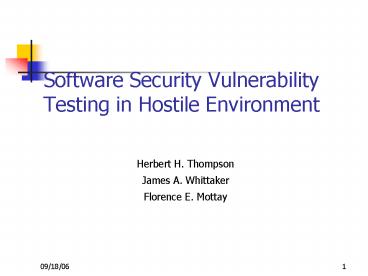Software Security Vulnerability Testing in Hostile Environment - PowerPoint PPT Presentation
Title:
Software Security Vulnerability Testing in Hostile Environment
Description:
Title: Software Security Vulnerability Testing in Hostile Environment Last modified by: Robert W. Lingard Document presentation format: On-screen Show – PowerPoint PPT presentation
Number of Views:90
Avg rating:3.0/5.0
Title: Software Security Vulnerability Testing in Hostile Environment
1
Software Security Vulnerability Testing in
Hostile Environment
- Herbert H. Thompson
- James A. Whittaker
- Florence E. Mottay
2
Introduction
- Functionality and Security Are Often in
Contention as Development Goals - Increased Functionality Leads to Decreased
Security - Increase Security requires less Software
Interaction with It Environment - Security Issues are left under-exercised or not
traversed at all due to the difficulty in
simulating a hostile environment - Network Failures during aremote transaction
- Disk Write errors, Memory Failures
- Such Failures Need to be Integrated into the Test
Cases
3
Placing a System under Stress
- A Security defect, in a general sense, is any
attribute of the software that violates policies
regarding access to resources - Sensitive information is written out to an
unencrypted file - Allows attackers to Deny access to a web server
by authorized users - Some Security vulnerabilities can be discovered
using conventional testing techniques - Many others security defects only surface when
the application is placed under stressed
environments - Sources of Stress load, memory or resource
deprivation, etc - When stress is present error handling routines
are executed
4
Continuation
- Three Basic Approaches to Introduce Environmental
failure - Code-Based Fault Injection
- External Stress Simulation
- Runtime Fault Injection
5
Symptoms of Security Defects
- Security failures derived from the interaction
with the environment - Reading/Writing Files
- Writing to the Registry
- Sending information across the network
6
Monitoring for Symptoms
- An application interaction with its environment
is its most critical behaviour - External Activities can be observed by monitoring
the System Calls the Application makes - Application can be monitored by getting in
between the application and the environment when
a system call is performed - To determine if there exist a security risk a
special tool can be used to provide system-level
design detail - Holodeck an application tool intercepts systems
calls and allows to view the interaction between
the application and its environment - Holodeck allows the tester to carefully examine
the interaction to find potential points of
security break
7
Different types of approaches for security
testing
- Code-Based Fault Injection
- Forces error conditions
- Error handling is white box in nature
- Involves modifying the source code and hard
coding return values - Forces the application to traverse a particular
path - Although efficient it has some problems
- Tester do not always have access to all the parts
of source code - Even with source code testers might lack
expertise of knowledge of the codes design and
structure to effectible implement the branch
testing - It is time consuming implementing those
situations at code level one instance per
situation
8
Continuation
- Example of Code-based Fault Injection
- hModule
- LoadLibraryEx(TEXT(msrating.dll),NULL,
- LOAD_LIBRARY-AS-DATAFILE)
- hModule NULL // Hard-Coded failure of
- //LoadLibraryEx
9
Different types of approaches for security
testing (cont)
- External Stress Simulation
- Involves simulating a high volume of activity on
the system - Accomplished by using an external application
that does not interact directly with the
application under test - Or by limiting disk or memory resources
- Large files
- Background processes, etc
10
Different types of approaches for security
testing (cont)
- Runtime Fault Injection
- Black box fault injection
- System calls are monitored and values returned by
these calls are controlled - Faults are simulated without changing the code of
the application - The application is placed in a realistically
hostile environment by inserting a runtime fault - A single system call can be isolated to
manipulate its response during stress situation
11
Conclusion































